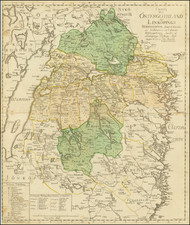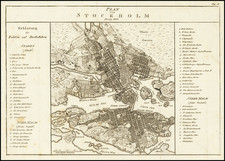Striking Plan Detailing the Trollhattan Locks & Canal, Published At The Time of the Opening of the Newest Lock System in August 1800
Highly detailed plan of the Trollhattan Canal and Locks by Fridrick Akrel in Stockholm.
The upper view illustrates the Trollhattan Falls and Rapids. The primary map provides a detailed mapping of the Falls area, locating the various locks and canal sections constructed through 1800.
At the bottom, a section of the Botha River is shown, extending from Gothenburg to Wenersbord, with the Trollhattan area shown just to the right of Brinkerbergs Kulle. Between the two maps, a profile view illustrates the 8 locks.
At the top left, a history of the Trollhattan Canal dating back to 1716 is given.
The Taming of Trollhättan Falls
This plan shows two different attempts to tame Trollhättan Falls. The falls had for centuries been a formidable obstacle for shipping to and from Gothenburg. The only resource that could be transported through the falls was timber for masts, and even these giant trees were often smashed as they floated through the more than thirty-meter drop. The lower part of the system of waterfalls was called Helvetestfallet, or Hell Falls.
Various plans were made to calm the cataracts and, in 1717, Christopher Polhem suggested a series of three locks to allow ships of up to 80 tons to descend and ascend the falls. Delayed by the death of Charles XII in 1718, the project only began construction in 1749, when the three locks—Ekeblad, Polhem, and Elvius—were blasted out of rock. However, only Ekeblad Lock was ever completed; an accident in 1755 halted construction. The three locks shown in profile on this plan were never used.
Polhem, who had died in 1751, had the right idea, but seemingly the wrong location and scale. Polhem’s plan had also called for a canal tunnel that had a low clearance. Ships with masts would have had to lower the masts to use the tunnel, an idea that made the entire plan unpopular and unfeasible. A different strategy was necessary, with a new site, farther from the falls and with a larger capacity for shipping.
Work began on a canal bypassing the locks in the 1770s, with a new design by Daniel Thunberg in 1776. The new canal, shown with Thunberg’s initial plan of ten locks instead of the eventual eight built, is shown on this plan. Built by the Trollhätte Lock and Canalworks Company, founded in 1793, the canal’s eight locks lowered or raised passing ships 32 meters. The capacity allowed ships of up to 140 to sail through, considerably more than Polhem’s plan. However, some ships were still too large for the locks and many shipowners upstream turned to a new fleet purpose built to fit in the locks. The canal opened to traffic on August 14, 1800.
Throughout the nineteenth century, new locks were built to allow ships with higher tonnage through the area. In 1832, the Göta Canal was completed, necessitating a new set of locks for larger vessels; these were completed in 1844 and allowed ships of 300 tons to pass. By 1916, the fourth generation of locks were shepherding cargoes of 4,000 tons down the falls. Today, 3.5 million tones of cargo pass through annually.












![[ Norway and Sweden ] Septentrionalium Regionum Suetiae Gothiae Norvegia Daniae](https://storage.googleapis.com/raremaps/img/small/67558.jpg)
![[ Southern Baltic Sea ] De Custen van Schoonen en Swede van Valsterboen tot Christianopolis Bornholm en de Custen van Pomeren van't Eylant Rugen tot Rygs-hooft](https://storage.googleapis.com/raremaps/img/small/67743.jpg)
![[Sweden] Gothia Auctore Andrea Bareo Sueco](https://storage.googleapis.com/raremaps/img/small/0209ops.jpg)